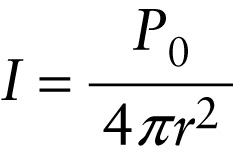Inverse-square law for sound waves (13-32)
Question
Intensity of a sound wave at a distance r from a source that emits in all directions
{"title":"Intensity of a sound wave at a distance r from a source that emits in all directions","description":"Correct!","type":"correct","color":"#99CCFF","code":"[{\"shape\":\"poly\",\"coords\":\"82,133\"},{\"shape\":\"rect\",\"coords\":\"10,16,12,16\"},{\"shape\":\"rect\",\"coords\":\"1,53,27,101\"}]"} {"title":"Power output of the sound source","description":"Wrong","type":"incorrect","color":"#ffcc00","code":"[{\"shape\":\"rect\",\"coords\":\"135,8,164,56\"}]"} {"title":"Distance from the source to the point where the intensity is measured","description":"Incorrect","type":"incorrect","color":"#333300","code":"[{\"shape\":\"rect\",\"coords\":\"170,113,198,147\"}]"}Review
Figure 13-23 shows how this comes about. Since waves carry energy, a source of sound waves is a source of energy. The rate at which the source emits energy in the form of waves is the power of the source. None of the power is lost as the waves spread away from the source, but at greater distances the power is distributed over a greater area. Hence the wave intensity (power divided by area) and the perceived loudness of the sound both decrease with increasing distance. If the source has power P0 and emits equally in all directions as shown in Figure 13-23, at a distance r from the source the power is spread uniformly over a spherical surface of radius r. The area of such a surface is 4πr2, so the intensity equals

